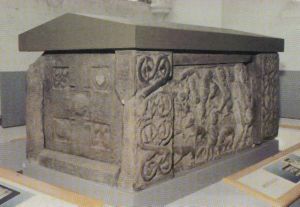
St Andrews Sarcophagus
Encyclopedia

Picts
The Picts were a group of Late Iron Age and Early Mediaeval people living in what is now eastern and northern Scotland. There is an association with the distribution of brochs, place names beginning 'Pit-', for instance Pitlochry, and Pictish stones. They are recorded from before the Roman conquest...
monument dating from the second half of the 8th century. The sarcophagus
Sarcophagus
A sarcophagus is a funeral receptacle for a corpse, most commonly carved or cut from stone. The word "sarcophagus" comes from the Greek σαρξ sarx meaning "flesh", and φαγειν phagein meaning "to eat", hence sarkophagus means "flesh-eating"; from the phrase lithos sarkophagos...
was recovered beginning in 1833 during excavations by St Andrew's Cathedral
St Andrew's Cathedral, St Andrews
The Cathedral of St Andrew is a historical church in St Andrews, Fife, Scotland, which was the seat of the Bishops of St Andrews from its foundation in 1158 until it fell into disuse after the Reformation. It is currently a ruined monument in the custody of Historic Scotland...
, but it was not until 1922 that the surviving components were reunited. The sarcophagus is currently on display at the Cathedral museum in St Andrews
St Andrews
St Andrews is a university town and former royal burgh on the east coast of Fife in Scotland. The town is named after Saint Andrew the Apostle.St Andrews has a population of 16,680, making this the fifth largest settlement in Fife....
, close to the site of its discovery.
Description
As originally constructed the sarcophagus would have comprised two side panels, two end panels, four corner pieces and a roof slab. The roof slab is entirely missing, as are most of one side and one end panel and a corner piece so that the extant sarcophagus is essentially L-shaped. The external dimensions of the sarcophagus are 177 cm by 90 cm and a height of 70 cm. The stone used is a local sandstone.The surviving side panel shows, from right to left, a figure breaking the jaws of a lion, a mounted hunter with his sword raised to strike a leaping lion, and hunter on foot, armed with a spear and assisted by a hunting dog, about to attack a wolf. Although it is not certain that the first two figures represent the same person, 19th century illustrations depict them as if they are. The surviving end panel is much simpler, essentially a cross with four small panels between the arms. The fragments of the missing end panel are similar, but not identical, to the surviving one.

